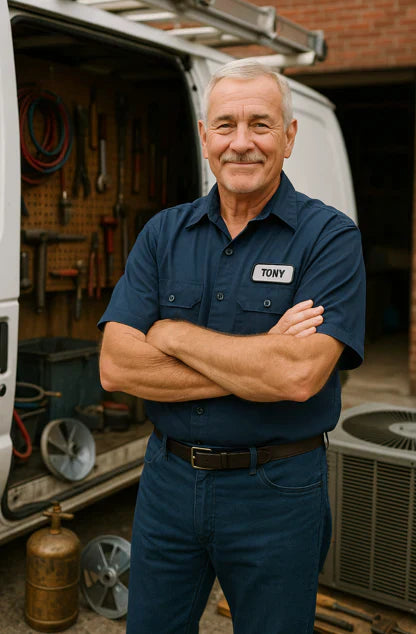🤔 Confused about what an air handler does versus a condenser or AC unit? You’re not alone. Tony the Trusted Tech walks you through the difference between these crucial components and why both matter for home cooling systems.
Let’s Clear the Air: Air Handler vs. Condenser
👋 Hey there—Tony here. If you’re trying to figure out the difference between an air handler and an AC unit, don’t feel bad. I’ve been in the HVAC business for over 25 years, and I still meet homeowners who mix them up all the time.
Thing is, they both matter, but they do very different jobs. And if you're shopping for a new system—like our 2.5 Ton 14.5 SEER2 R-32 System—you'll need to understand how these pieces work together to keep your home cool and efficient.
Let’s break it down, plain and simple.
What Is an Air Handler?
The air handler is the indoor part of your HVAC system. It looks like a metal cabinet and typically lives in a closet, attic, or garage. Inside, you’ll usually find:
⚙️ A blower motor to move air
⚙️ An evaporator coil to cool the air
⚙️ Air filters and control boards that help regulate system performance
Think of the air handler as the lungs of your HVAC system—it circulates the cooled (or heated) air throughout your home using ductwork. But here’s the key: it doesn’t cool the air by itself. That job starts with the outdoor unit—the condenser.
📚 Want a more detailed explanation? HVAC.com has a helpful guide that breaks down what an air handler is and how it fits into your home’s HVAC system.
What Is a Condenser?
The condenser (sometimes just called the AC unit) is the outdoor part of your system. It contains:
⚙️ The compressor
⚙️ A fan
⚙️ Condenser coils
⚙️ Refrigerant lines
Its job? To release heat collected from inside your home. It pulls in refrigerant that has absorbed indoor heat (from the air handler), compresses it, and dumps the heat outside.
If the air handler is the lungs, the condenser is the heart—pumping refrigerant and handling the heavy lifting when it comes to cooling.
💡 According to Energy.gov, a split system like this is standard in most U.S. homes and is one of the most efficient ways to stay comfortable.
Air Handler vs. AC Unit (Condenser): Key Differences
| Feature | Air Handler | Condenser (AC Unit) |
|---|---|---|
| Location | Indoors | Outdoors |
| Function | Circulates indoor air | Releases heat outdoors |
| Contains | Blower, evaporator coil | Compressor, condenser coil |
| Needs Ductwork? | Yes | Yes |
| Controls? | Airflow, distribution | Temperature regulation via refrigerant |
Why You Need Both
Here’s a common question I hear:
⁉️ “Can I run my AC with just an air handler?” ⁉️
👎 Nope. You can’t have one without the other.
An air handler without a condenser won’t cool the air—it just moves it. And a condenser without an air handler won’t have a way to deliver that cooled air into your living spaces.
That’s why systems like the Goodman 2.5 Ton SEER2 R-32 System come as a matched pair—engineered to work efficiently together. If you mismatch components, you risk poor performance, higher energy bills, and even system failure.
When to Replace One vs. Both
I’ve been on service calls where homeowners try to replace just one component—usually to save money. Here’s my advice:
⚙️ If your air handler is toast but the condenser is fairly new and compatible, you might get away with a single replacement.
⚙️ But often, it makes more sense to replace both together. That way, you:
✔️ Get a matched SEER2 efficiency rating
✔️ Avoid future repairs on aging parts
✔️ Stay under warranty (many manufacturers require matched systems)
For example, with our Goodman system, both the air handler and condenser are designed to run with R-32 refrigerant, which is more efficient and eco-friendly than R-410A. You don’t want to mix refrigerants or mismatched coil designs.
💭 Final Thoughts from Tony 💭
So, let’s wrap it up. When you hear folks compare air handler vs. AC unit, now you know:
✔️ Air handler = indoor air mover
✔️ Condenser = outdoor heat ejector
✔️ You need both for central cooling to work.
If you're building a new system or upgrading an old one, don't just swap out one part unless you're sure it's compatible. Go with a matched system like the 2.5 Ton Goodman SEER2 R-32 unit, and you'll get reliable comfort, energy savings, and long-term peace of mind.
Have more questions about system sizing or which components are right for your home? Reach out to us over at The Furnace Outlet—I’m always around to give honest advice, no fluff!
🛠️ From my toolbelt to your thermostat, stay comfortable,
– Tony the Trusted Tech 🛠️







